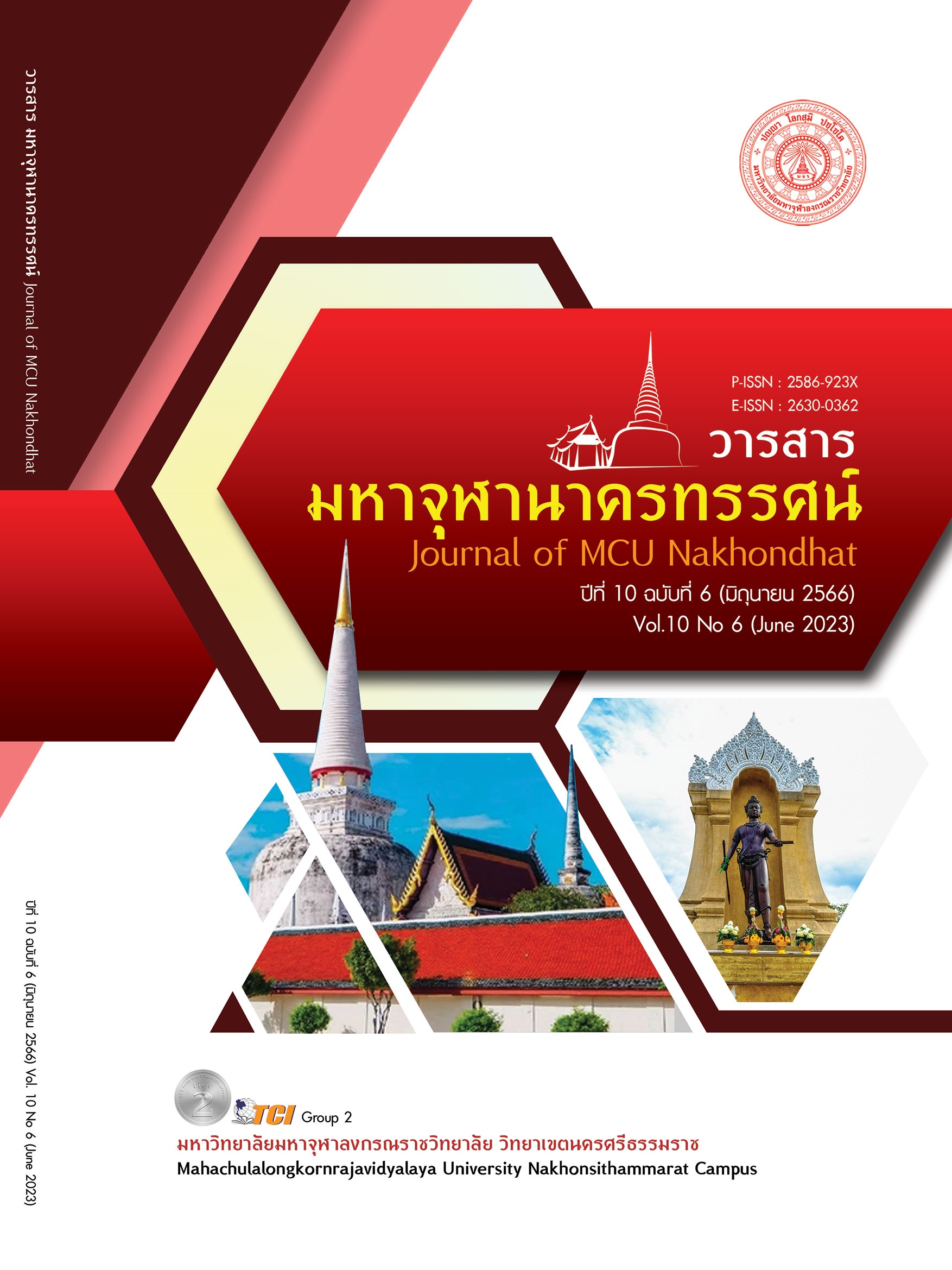อิทธิพลของการใช้อารมณ์ขันของผู้นำต่อความสัมพันธ์ระหว่างภาวะผู้นำและ พฤติกรรมการทำงานเชิงนวัตกรรม: บริษัท ไปรษณีย์ไทย จำกัด
Main Article Content
บทคัดย่อ
การวิจัยครั้งนี้มีวัตถุประสงค์เพื่อ ศึกษาอิทธิพลของการใช้อารมณ์ขันของผู้นำต่อความสัมพันธ์ระหว่างภาวะผู้นำการเปลี่ยนแปลงและพฤติกรรมการทำงานเชิงนวัตกรรมของส่วนงานภายในบริษัท ไปรษณีย์ไทย จำกัด โดยใช้รูปแบบการวิจัยเชิงปริมาณ ประชากร ได้แก่ ส่วนงานภายในบริษัท ไปรษณีย์ไทย จำกัด จำนวน 104 ส่วนงาน กลุ่มตัวอย่าง ได้แก่ ส่วนงานภายในบริษัท ไปรษณีย์ไทย จำกัด จำนวน 104 ส่วนงาน ใช้เทคนิคการสุ่มตัวอย่างแบบกลุ่ม ภายในส่วนงานภายในของบริษัท ไปรษณีย์ไทย เครื่องมือที่ใช้ ได้แก่ แบบสอบถามมาตราส่วนประมาณค่า 6 ระดับ จำนวน 1 ฉบับ เก็บรวบรวมข้อมูล โดยแจกแบบสอบถามให้ทั้ง 104 ส่วนงาน ส่วนงานละ 8 ชุด รวม 832 ชุด ได้รับแบบสอบถามกลับคืนมาจำนวน 100 ส่วนงาน จำนวนที่สมบูรณ์ 799 ชุด สถิติที่ใช้ในการวิเคราะห์ข้อมูล ได้แก่ ความถี่ ร้อยละ ค่าสูงสุด ค่าต่ำสุด ค่าเฉลี่ย ส่วนเบี่ยงเบนมาตรฐานและค่าสัมประสิทธิสหสัมพันธ์ วิเคราะห์ข้อมูลด้วยวิธีวิเคราะห์ถดถอยพหุคูณเชิงชั้น ผลการวิจัย พบว่า การใช้อารมณ์ขันของผู้นำมีอิทธิพลเชิงบวกอย่างมีนัยสำคัญทางสถิติต่อความสัมพันธ์ระหว่างภาวะผู้นำการเปลี่ยนแปลงและพฤติกรรมการทำงานเชิงนวัตกรรม ผู้นำส่วนงานของ ปณท มีแนวโน้มที่จะใช้อารมณ์ขันแบบเป็นกันเอง กับอารมณ์ขันแบบส่งเสริมตนเอง ซึ่งเป็นอารมณ์ขันเชิงบวก ในขณะที่ อารมณ์ขันแบบก้าวร้าว ซึ่งเป็นอารมณ์ขันที่เป็นพิษภัยกับผู้อื่นแต่กลับส่งเสริมตนเองกลับไม่มีความสัมพันธ์กับภาวะผู้นำการเปลี่ยนแปลงและพฤติกรรมการทำงานเชิงนวัตกรรม และพบว่า การใช้อารมณ์ขันแบบโจมตีตนเองนั้น ซึ่งเป็นอารมณ์ขันที่เป็นพิษภัยกับตนเองแต่กลับส่งเสริมความสัมพันธ์กับผู้อื่น ไม่เหมาะกับบุคคลที่มีภาวะผู้นำแบบภาวะผู้นำการเปลี่ยนแปลง
Article Details

อนุญาตภายใต้เงื่อนไข Creative Commons Attribution-NonCommercial-NoDerivatives 4.0 International License.
เอกสารอ้างอิง
บริษัท ไปรษณีย์ไทย จำกัด. (2565). รายงานประจำปี 2564. บริษัท ไปรษณีย์ไทย จำกัด. เรียกใช้เมื่อ 15 มกราคม 2565 จาก https://file.thailandpost.com/upload/ content /2564_63355f0830859.pdf
AlMulhim, A. F. (2020). Linking Knowledge Sharing to Innovative Work Behavior: The Role of Psychological Empowerment. Journal of Asian Finance, Economics and Business, 7(9), 549-560.
Arendt, L. (2009). Transformational Leadership and Follower Creativity: The Moderating Effect of Leader Humor. Review of Business Research, 9(4), 100-106.
Avolio, B. J. et al. (1999). A Funny Thing Happened on the Way to the Bottom Line: Humor as a Moderator of Leadership Style Effects. Academy of Management Journal, 42(2), 219-227.
Basu, R. & Green, S. G. (1997). Leader-Member Exchange and Transformational Leadership: An Empirical Examination of Innovative Behaviors in Leader-member Dyads. Journal of Applied Social Psychology, 27(6), 477-499.
Clouse, R. W. & Spurgeon, K. L. (1995). Corporate Analysis of Humor. Psychology: A Journal of Human Behavior, 32(3-4), 1-24.
Cohen, J. (1998). Statistical Power Analysis for the Behavioral Sciences. (2nd ed.). Hillsdale, NJ: Lawrence Erlbaum Associates, Publishers.
Conger, J. A. (1989). The Charismatic Leader: Behind the Mystique of Exceptional Leadership. San Francisgo, CA: Jossey-Bass.
Craumer, M. (2002). Getting Serious about Workplace Humor. Harvard Management Communication Letter, 5(7), 3-4.
Csikszentmihalyi, M. (1997). Creativity: Flow and the Psychology of Discovery and Invention. New York, NY: Harper Collins Publishers.
Davis, A., & Kleiner, B. H. (1989). The Value of Humour in Effective Leadership. Leadership & Organization Development Journal, 10(1), 1-3.
De Jong, J. & Den Hartog, D. (2010). Measuring Innovative Work Behaviour. Creativity and Innovation Management, 19(1), 23-36.
Denti, L. & Hemlin, S. (2012). Leadership and Innovation in Organizations: A Systematic Review of Factors that Mediate or Moderate the Relationship. International journal of Innovation Management, 16(3), 1-20.
Dienstbier, R. A. (1995). The Impact of Humor on Energy, Tension, Task Choices, and Attributions: Exploring Hypotheses from Toughness Theory. Motivation and Emotion, 19(4), 255–267.
Dixon, N. F. (1980). Humor: A Cognitive Alternative to Stress? In I. G. Sarason & C. D. Spielburger (Eds.). Stress and Anxiety, 7(1980), 281-289.
Dubinsky et al. (1995). An Examination of Linkages between Personal Characteristics and Dimensions of Transformational Leadership. Journal of Business and Psychology, 9(3), 315-335.
Duncan, W.J. (1982). Humor in Management: Prospects for Administrative Practice and Research. Academy of Management Review, 7(1), 136-142.
Gifford W. et al. (2011). Developing Team Leadership to Facilitate Guideline Utilization: Planning and Evaluating a 3-Month Intervention Strategy. Journal of Nursing Management, 19(1), 121-132.
Gruner, C.R. (1997). The Game of Humor: A Comprehensive Theory of Why We Laugh. New Brunswick, NJ: Transaction.
Ho, L.H. et al. (2011). Influence of Humorous Leadership at Workplace on the Innovative Behavior of Leaders and their Leadership Effectiveness. African Journal of Business Management, 5(16), 6674-6683.
IMD. (2022). IMD World Talent Ranking 2022. Retrieved March 20, 2023, from https://imd.cld.bz/IMD-World-Talent-Ranking-2022
Kenny, D.A. (2018). Moderation. เรียกใช้เมื่อ 20 March 2023 จาก http://davidakenny.net/cm/moderation.htm
Kerr, S. & Jermier, J. M. (1978). Substitutes for Leadership: Their Meaning and Measurement. Organizational Behavior and Human Performance, 22(3), 375-403.
Kock, N. & Lynn, G.S. (2012). Lateral Collinearity and Misleading Results in Variance-Based SEM: An Illustration and Recommendations. Journal of the Association for Information Systems, 13(7), 546-580.
Kock, N. (2015). Common method bias in PLS-SEM: A Full Collinearity Assessment Approach. International Journal of e-Collaboration, 11(4), 1-10.
Malone, P. B. (1980). Humor: A Double-Edged Tool for Today's Managers. Academy of Management Review, 5(3), 357-360.
Martin, R. A. & Lefcourt, H. M. (1983). Sense of Humor as a Moderator of the Relation between Stressors and Moods. Journal of Personality and Social Psychology, 45(6), 1313-1324.
Martin, R. A. et al. (2003). Individual Differences in Uses of Humor and their Relation to Psychological Well-Being: Development of the Humor Styles Questionnaire. Journal of Research in Personality, 37(1), 48-75.
Romero, E.J. & Cruthirds, K.W. (2006). The Use of Humor in the Workplace. The Academy of Management Perspectives, 20(2), 58-69.
Ziv, A., & Gadish, O. (1990). The disinhibiting effects of humor: Aggressive and Affective Responses. Humor: International Journal of Humor Research, 3(3), 247-257.


